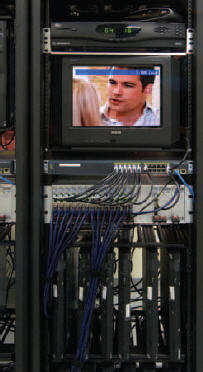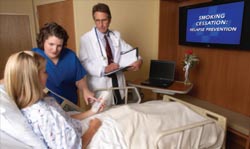- METRO HEALTH CONVERGES TECHNOLOGIES OVER IP NETWORK TO EDUCATE AND ENTERTAIN ITS PATIENTS.
Patients might find themselves looking for the mint on their pillow after a day or two at the new Metro Health Hospital near Grand Rapids, MI. It's just
the kind of personalized service one might expect from a five-star hotel - meals delivered to your private room, seemingly endless choices of television and movies on big screen TVs - even wireless internet access when and where you want it.
Since opening the doors to a brand new 208-bed facility just over a year ago, Metro Health has been receiving high marks for patient satisfaction, not just for its cuttingedge healthcare technology, but also for its innovative IP-based patient education and entertainment system that goes above and beyond the norm.
FINDING THE RIGHT FIT
IP-based entertainment systems caught the eye of Metro Hospital planners long before the first brick was laid. Since the new hospital would already have an IP infrastructure, running coaxial cable seemed redundant and too limiting.
"At that point, you're creating an isolated technology," says Metro Health IT manager Art King. "It's the delivery of TV and end of story."
Metro wanted far more than TV, but finding a system that gave them everything they wanted wasn't easy. Many of the IP-based systems they looked at offered no flexibility in terms of content and were basically leased, not owned. "They wanted you to pay per patient room, per day," says King. "Whether there was a patient in there or not."
In the end, Metro Health found the answer right down the road at Optimal Solutions, a Wyoming, MI firm that has been offering TCP/IP video management and delivery in educational settings for a dozen years, but had never ventured into the healthcare market.
"Optimal as a company has always looked for technological solutions in the IP space," says Scott King, Optimal's director of Convergent Technologies. "Metro Health approached us knowing that we were doing IPbased delivery of video and asked if it would work in their environment. The answer was, 'No,' because we designed our system specifically for education, but we were very interested in developing something for them because it seemed to fit our mission."
Optimal's eVideon Software is a cataloging and management tool for digital video assets designed originally for the K-12 market. Using that as a cornerstone, along with the hospital's specifications for the scope of their new system, Optimal created an entirely new application designed specifically for the needs of the healthcare industry, using IPTV technology to merge the systems.
PLAYS WELL WITH OTHERS

Roundabout Theatre Company's Sunday In the Park With George used Zaxcom's TRX900 digital wireless microphone systems. (Photo Credit: Joan Marcus) center. The first server manages and categorizes all digital media - live TV, 60 movies on demand, and over 400 patient education videos. Those videos and the movies are stored on the second server to be accessed when a patient calls for them. The third server manages the Amino set top boxes (also supplied by Visionary Solutions). "There's nothing sexy about that server," says King. "It offers extended control of the set top boxes at each TV location. If I want to send a command to all the STBs at once, in case of emergency or something like that, I can do that with this server."
Because the entertainment system is completely IP-based, Optimal installers were able to connect it to the hospital's HL7 network, a nationally accepted protocol that allows health systems to talk to each other. By connecting the IP network to the HL7 network, the system can access all patient records, entertainment, educational videos, and even admissions information.
GETTING TO KNOW YOU
"Basically, if you're a patient here, when you get to your room the TV screen is going to welcome you by name," says Bill Lewkowski, executive vice president and CIO at Metro Health. "It knows who you are and why you're here."
Once a patient is registered and given a bed, the software automatically assigns appropriate videos to that room. Since all rooms are private, the media content can be personalized. A 7-year-old child isn't going to have access to PG-13 movies. A cardiac patient may have heart education videos available. A newly diagnosed diabetic will find insulin information and how-to videos among his choices. With over 400 patient education videos in the system, physicians are still reviewing all the videos to make sure the content is correct. Once approved, nurses can assign the videos to patients as needed during treatment.
Since the system is IP-based, no actual TV tuner is required, so every patient room has a 37-inch LG 3701 LCD monitor on the wall accompanied by an Amino set top box. Optimal converted the standard pillow speaker in every room to act as a remote, so when a patient clicks a button on his pillow speaker, the STB picks up the signal through a custombuilt interface box. The interface translates the speaker protocol to a language the STB will understand.
AT WHAT COST
Putting a price tag on the project is difficult, according to Lewkowski, because there are so many different components to the system, which Metro Health paid for through its building fund. "We went out and contracted for satellite service, then bought the patient education videos," says Lewkowski. "We also bought monitors for every room, so a lot depends on how large your system is going to be."
Scott King says the addition of VSI 220 encoder blades saved on both money and space. "VSI delivers the best cost ratio for each TV channel you want to stream live, giving us 15 megabits per second bandwidth - basically DVD quality. Before we were introduced to VSI we had to either build our own encoders or use another company's encoders, which were higher cost. Visionary's chassis-based solution saves a lot of space on the racks as well." King also feels the system is more robust since the VSI encoders use hardware, not software, to convert analog to digital.
Visionary Solutions president Will Bakewell says this project was a perfect fit. "The extensive access and control delivered by the Optimal Solutions middleware really adds value to a system like this. IPTV saves money in terms of infrastructure, and it definitely enhances the hospital's patient care."
One of the largest cost savings occurred this summer when Metro Health opened a new cancer center across the street from the hospital. Since the new building already required an IP network, expanding for patient entertainment was simple.
"Adding TVs to the eVideon system was like adding a computer on a network," says Scott King. "No big deal. If they'd had a traditional coaxial system they wouldn't have been able to offer TV over there without a whole new head end or massive costs to extend the one they had."
INFINITE POSSIBILITIES
The hospital plans to have all patient medical records stored electronically by the end of 2009, which opens up even more possibilities for this system. "I see that integration growing," says Art King. "As we get full electronic medical records, we'll be able to see what patients have viewed, or still need to view, as they come in or out."
"This system is both expandable and versatile" says Lewkowski. "This is absolutely the way patient technology is going in the future."
In the meantime, Lewkowski is sure the hospital's patient satisfaction ratings will remain high. "We would like this to be as pleasant a stay as if you are staying in a nice hotel. You should have a lot of services at your fingertips. You're in the bed. We might as well give you something to do."
CONTROL OPTIONS FOR THE DISABLED
One unique feature of the Metro Health entertainment system is its ability to give some control to patients with very limited abilities. At least 42 Michigan Assisted Breathing Center patients live long-term at Metro Health, many of them quadriplegics and on ventilators. By switching their systems into eVideon's "Easy Access Mode," these patients have choices.
"Some of these patients have no control of their extremities," says Scott King. "They have minimal control of their environment through things like the sip and puff device. Basically they breathe in and out of a straw to accomplish some simple day-to-day tasks. Or they may have a switch taped to their forehead. When they move the muscles in their forehead it presses the button that lets them call the nurse, or control some things in their environment. Now they also have control over our whole eVideon system with the same devices."
INFO
METRO HEALTH:
www.metrohealth.net
EVIDEON: www.evideon.com
OPTIMAL SOLUTIONS: www.optimalinternet.com
VISIONARY SOLUTIONS, INC.:www.vsicam.com
LG ELECTRONICS: www.lge.com
